Inca quarry
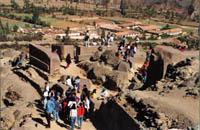
Inca stone buildings
The Incas lived in the Peruvian area. XV. and XVI. for centuries. The main characteristic of its architecture lies in the use of stone, unlike the civilizations of the area, in which the coastal ones, for example, only used clay. The Inca houses and temples had a single floor and a rectangular plan. The windows and doors were trapezoid, with a wide base and a narrow, blind or open lintel. Consequently, doormen, shutters and sides were always oblique. For most of them they were given that aspect with the intention of obtaining protection against the earthquake, since it cannot be forgotten that in the area frequent earthquakes occur. Before the construction of the masons began, the architects made clay models.
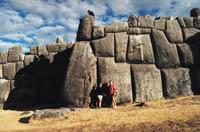
The immense dimensions and solidity of the buildings that were built make it seem fascinating and surprising today to anyone who has stood before them. Many of the stones used were cushioned, that is to say, with the face to the sight a little agreed, thus producing a strange aesthetic effect. It should also be noted the importance they gave to the polishing of the stones and their subsequent placement in their corresponding place. They worked with precision, which allowed them to build imposing structures, although they did not know the arches and vaults.
Peruvian stonemasons used three types of stones: limestone, which was cut into large polygonal pieces to build various structures, such as agricultural terraces, fortresses, walls, canals and irrigation reservoirs. The second type of rock was a hard diorlytic porphyry that was also worked on large polygonal pieces and was used for structures under high pressure, especially for retaining walls against water and soil. Finally, it is a black andesite that was reserved for rectangular masonry of the buildings. These masonry walls were always the same size and were placed through regular and parallel rows. With this type of stones were built the most important buildings of the empire, especially of Cuzco.
The most significant examples of Inca architecture are in the area of Cuzco. Among them are Ollantaytambo and Sacsayhuaman. Both cities are surrounded by walls, the first of them surrounded by two walls and the second of a hill, three. Both cities are built with large blocks of stone. When the Spanish conquerors arrived there, they believed they were military fortresses, but according to later writings it seems that they were linked to religious questions.
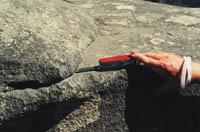
Another example of the construction of the Incas is the city of Machu Picchu, located at the top of the narrow foz of the Urubamba River. The best protection against possible enemies provided by the chosen place to build the city. In fact, it is so difficult to reach until in 1912 it was discovered by an American archaeologist, who was totally unknown.
Cuzco Boom XV. It arrived in the mid-twentieth century, with the mandate of the ninth Inca king Pachacutec. According to the researchers, it was then that the most important buildings and palaces of the city were built. On the other hand, according to some chroniclers, the king himself made clay models of the buildings to indicate where and how they were built. Pachacutec reurbanized the entire city center, and to carry out this work, according to some historians, alienated citizens living in an area of several kilometers around the central square of the city. To carry out this huge work it took twenty years and worked more than 50,000 workers.
All the kings after Pachacutec made important constructions. Some of them, like the city of Sacsayhuaman itself, are huge. For this reason, some archaeologists and architects claim that the Incas resorted to slavery when they were going to perform such works.
The Spaniards arrived in Cuzco on November 15, 1533, after which the city underwent a change of image. The Spaniards built churches and stately houses on ancient Inca constructions, often with pre-existing stones.
Three years after the arrival of the conquerors, Manco Inka tried to recover the capital, but it did not succeed. After meeting his soldiers in Sacsayhuam, he organized the siege of the capital of Cuzco. The siege lasted ten months and although the Spaniards beat Manco Inka, he managed to escape. It should be noted that during the siege several buildings of the capital were burned.
At present, the remains of Inca constructions can be seen in Cuzco alongside those of colonial style.
Quarry: stone extraction
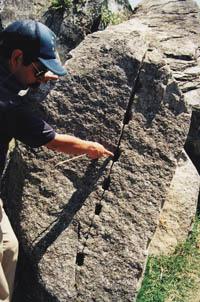
Activities of great importance in the Inca culture were the thaw and the carving of gold and silver. These are truly skillful works, which served to decorate and beautify sacred places and main buildings. However, metals such as copper and bronze were not used, so appropriate for the manufacture of tools, which was a major drawback for the extraction of stone from quarries and subsequent laboreo. The procedure used by the Incas for the realization of these works is the same that was used by ancient civilizations spread all over the world.
The process can be summarized as follows: first they made holes in the rock by means of slabs of mud; the holes, which were equidistant, were made by the line they wanted to cut the rock. After giving sufficient depth to the holes, impregnated wooden wedges were introduced. With the passage of time, the extension of the wood caused strong tensions that ended up exceeding the breaking point of the rock. Consequently, the rock broke into the weakest point, right on the line linking the holes.
It should be noted that there are still stones of this type in the vicinity of the quarries used by the Incas, which can be observed perfectly in the fracture that occurs through the line that joins the holes and holes left by the wedges (see photo left).
Once extracted from the quarry, very basic tools were used to work the stones: mallets, axes, chisels and buriles, all of them made of stone. The stones had an appropriate shape to be transported from one place to another using tools.
However, it seems that there were also metal threads, probably of copper, to cut with great precision the extracted stones. It seems that the stones are rubbed with metallic thread until the breakage lines occur. The cutting lines that can be seen in some of the stones located in the quarry of the Ollantaytambo area, with a depth of 10 cm and a thickness of few millimeters, bet on the hypothesis that metal was also used in the work of the stones (see image above).
Once the extraction work was completed, it was a long and hard process of moving the stone to the goal.
Transport of blocks to destination
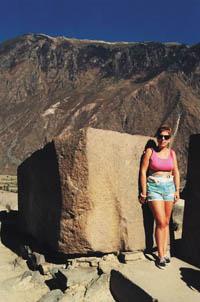
First of all, it should be noted that they did not have any vehicles to transport the stones, since they did not know the wheel, not even the help of the animals, which forced to resort to human force; however, using rollers and ramps of earth and stone, and with the help of several people who threw strong and long ropes, they were able to get the Incas to the most incredible places.
Some of the stone blocks that did not reach the goal have been found on smaller stone ramps, and this type of findings have allowed us to know the details of the transport system used by the Incas. In the opinion of some, the transport of stones from one place to another was made by trunks that allowed to carry the stones on them in pyrite; despite the widespread conviction, no evidence has been found.
The ropes used for the transport of heavy weights were extracted from a plant, specifically from the ágabe. The plant has broad leaves and long, sharp thorns. Each agabe has about fifteen leaves, with double-width leaves and some reach a length of 1.5 m. The Incas dried the leaves of the plant in the sun after the extraction of the inner pulp. When they were dry the fibres were removed and once cleaned they returned to make laces. The laces also had to be folded to form inch thick ropes; finally, the ropes thus made were joined at the ends and obtained cables as strong as to transport stones.
Among the remains of construction of Ollantaytambo is an example of the construction of the Inca empire. In view of the location of some of the stones of a temple, with a height difference of 100 meters, and considering that there is no quarry in it, it is very difficult to understand how they got the stones to rise to the height. The explanation is also not simple: the giant stones used for the building were brought across the valley below the temple. Therefore, in addition to facing the aforementioned slope, they had to cross the river that runs through the valley.
Let's see below the steps they had to take. Once the stones were removed, they went down from the quarry to the valley. Later, with the intention of crossing the river, a curious method was used: a small island located on the same river was used to divert the water stream, thus carrying the heavy load to the other side. They built a retaining wall from one shore to the islet, bringing the waters to one side. Thus, the loaders could cross half a river. Then the retaining wall was opened and the same operation proceeded to the other side of the river until the load moved to the other bank. Then they had to go up through the ramps on the hillside. The ramps of that time remain visible on the hillside.
Laying stones
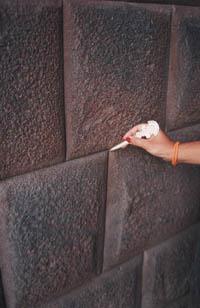
Once the stones were removed and transported, they were placed in the corresponding place. The tools and resources used were those mentioned above. On many occasions, once the stones were placed on the walls, they were applied as a pad, using wet sand for polishing. Another remarkable feature is that the polygonal stones fit together perfectly. Keep in mind that they did not use cement or lime paste to join the pieces. The procedure they followed consisted in making the necessary corrections when the stones were worked and polished.
At the edge of several stones are bulges in a circular shape. Apparently, during the transport and installation of the stones, these openings were used as knobs, but then, in order to give the buildings a more elegant appearance, the openings were softened by placing the stones in place.
To fit a few pieces in others, two techniques were mainly used: the best known, and that can be seen in several buildings, was to play with the angles of the stones, in this way they fit every corner of a stone in one of the entrances of the next. The second system is male/female. In this case, in the stones there were lumps, often in the form of a key, which were inserted into the holes made specifically in the lateral stones.
The results obtained in both techniques were optimal. Today many Inca buildings, especially in Cuzco, have been demolished or unfortunately altered. Many of the roads used by the Incas have also been paved and cars circulate through them as in any other city in the world. However, some Inca constructions still stand and remind us that there was once another civilization in the area.
Buletina
Bidali zure helbide elektronikoa eta jaso asteroko buletina zure sarrera-ontzian











